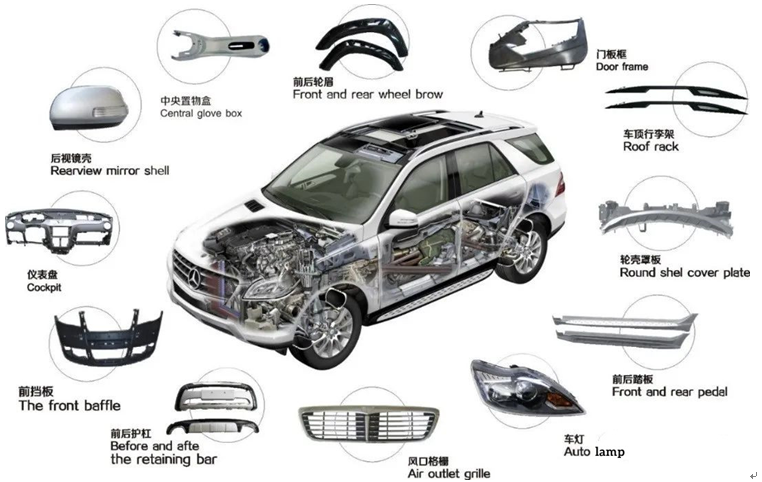©Copyright 2019 SIKO POLYMERS (SUZHOU) CO., LTD All rights reserved.Site Map Powered by iwonder.cn
- Email Uskevin@sikopolymers.com


At present, under the global development keynote of emphasizing "double carbon" strategy, saving, green and recycling have become the development trend of new automotive materials and new technologies, and lightweight, green materials and recycling have become the main development direction of new automotive materials. Driven by the wave of automotive lightweight, plastic materials have become more widely used in the field of automotive because of their outstanding weight reduction effect. Whether it is the exterior decorative parts of the car, the interior decorative parts such as the instrument panel, the door panel, the auxiliary instrument panel, the glove box cover, the seat, the rear guard plate, or the function and structure parts, you can see the shadow of plastic everywhere. Especially at present, new energy vehicles have become the main direction of the transformation and development of the global automotive industry. The lightweight of new energy vehicles is more urgent than that of traditional cars. The application scope of plastic materials has been expanded to new new energy vehicle battery shell and other components. At the same time, the flame retardant, high environmental protection, scratch resistance, high gloss, corrosion resistance and other performance of automotive plastics also put forward higher challenges.

The application of several plastic materials commonly used in automotives
PA
Polyamide PA is commonly known as Nylon. Excellent mechanical properties, tensile, compressive and wear resistance. PA6, PA66, enhanced flame retardant PA6 are used in automotive engine and engine peripheral parts, engine cover, engine trim cover, cylinder head cover, oil filter, wiper, radiator grille, etc.
PA66
PA66 was obtained by polycondensation of adipic acid and hexandiamine at a molar ratio of 1:1. Adipic acid is usually produced by hydrogenation of pure benzene and oxidation with nitric acid. PA66 can also maintain strong strength and stiffness at higher temperature; PA66 has high mechanical strength, good stress cracking resistance, and is the best wear resistance nylon; PA66 self lubricating excellent, second only to PTFE and polyformaldehyde; PA66 has good thermal property and is a self-extinguishing material, but its water absorption is large, so its dimensional stability is poor.
PA6+GF30
PA6 GF30 is the result of modification of PA6. PA6 GF30 enhances material properties by adding glass fibers. Glass fiber itself has heat resistance, flame resistance, corrosion resistance, heat insulation, high tensile strength and good electrical insulation. After reinforced by glass fiber, PA6 GF30 products can meet the requirements of industrial and daily use, and has the characteristics of excellent strength, heat resistance, impact resistance and dimensional stability.
PMMA+ASA
PMMA, commonly known as "plexiglass". It has good light transmittance, mechanical properties and excellent aging resistance and weather resistance. But its brittleness is high, easy to crack, impact resistance is poor.
ASA, similar in structure to ABS, uses acrylic rubber without double bonds instead of butadiene rubber in ABS. Has excellent flexibility, good weather resistance, and better resistance to chemical corrosion. But its surface hardness is not high, scratch resistance, wear resistance is not good.
ABS
ABS is acrylonitrile - butadiene - styrene copolymer, it is a very versatile thermoplastic engineering plastic, its impact resistance, heat resistance, low temperature resistance, chemical resistance and excellent electrical properties, but also has easy processing and products good size stability, surface gloss, mainly used for automotive air conditioning tuyere, switch, instrument parts around, freeze protection plate, door handles, Bracket, wheel cover, reflector housing, fender safety handle, etc.
PC/ABS alloy
PC/ABS (P acrylonitrile - butadiene - styrene copolymer alloy) : the advantages of PC is tough and tough, the disadvantage is stress cracking, viscosity; The advantages of ABS are good fluidity, but low surface hardness; In this way, the blended material P/ABS retains the advantages of both; PC/ABS has high surface hardness, high rigidity and toughness, and high stress cracking resistance; Its mechanical properties are somewhere in between. PC/ABS alloy in the car dashboard, door handle, bracket, steering column sheath, decorative plate, air conditioning system accessories, car wheel cover, reflector shell, tail lampshade and many other places are used.
Future development of automotive plastics
Increased consumer demand for fuel-efficient, durable and lightweight vehicles will stimulate the demand for plastics in the automotive industry. Among the plastics used in automobiles, the use rate of general plastics (such as PP, PE, PVC, ABS, etc.) accounts for about 60%, while the use rate of engineering plastics (such as PA, PC, PBT, etc.) accounts for about 18%. Therefore, for modern cars, whether it is the interior decoration, exterior decoration, or the functional structure of the car, a considerable number of parts have begun to use plastic parts instead of steel parts, that is, the automotive field of "plastic instead of steel" trend prevailing.